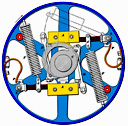
| Earth & Moon size | |||
General information
The general outline is:
ResourcesASP's Project Astro Universe at Your Fingertips, section activity D-2 "A 3-D Model of the Earth and the Moon." I stumbled across some activities from here: http://www.esbd.org/ that also might have tie ins, but I can not say if they help (ESBD looks to be an entire program vs. Project Astro as an enhancement to other activities). MaterialsSee Activity D-2.
|
|||
General plan |
|||
Visittime: 60-90 minutes This one I more or less follow the activity guide. I add a little bit on models and how they are used for testing hypothesis to build up theories. For 4th graders we use the handout to help guide the math aspects, filling in the blanks as we go along. I have them guess how many balls should make up the earth vs. the moon. For part 3 we actually cut a piece of yarn so they can put the moon at the right distance from the earth. I end with how far/big other things would be at this scale (and it leaves a logical tie in to the solar system scale model). (Apologies to those in the civilized world that use metric measurements) With one can of play dough you end up with a 2 inch earth and 1/2 inch moon, so it's easy for them to calculate the ratio. With two cans (or one of the larger cans) you end up with a 3 inch earth and 3/4 inch moon, and they may not know how to divide those yet. A fallback is to call it $3.00 and 75 cents, and then they can figure it out. ExtraIn one of the followup Q&A the question of motion came up. While the math is still all very basic, the size of the numbers can throw them off. I created an "extra credit" worksheet (pdf or doc) to guide any of the more motivated students that want to try to figure out orbital speeds.
|
|||
| Notes | |||
Visit length: It can probably be done in 60 minutes, but I think it's good to let them work on the math at each step, and checking the work as you go along, etc. This exercise is also a lead-in to the 1000 yard solar system model. Some extra numbers (in English measurements) Earth diam: 7912 mi Earth - moon distance: 238,835 miles (225k to 252k) volume = (4/3) PI r^3 |
|||
|
|||